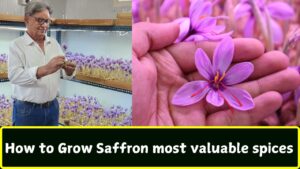How to Grow Saffron most valuable spices
How to Grow Saffron
Saffron is one of the world’s most valuable spices, prized for its vibrant color, distinct aroma, and unique flavor. Derived from the stigmas of the Crocus sativus flower, saffron cultivation requires careful planning and management due to its labor-intensive harvesting and specific growing conditions. This summary provides a detailed guide on saffron farming, from preparation to marketing.

Introduction to Saffron Cultivation
Saffron holds significant cultural, culinary, and economic value. Due to its high demand and limited production, it is one of the most expensive spices globally. Growing saffron can be highly profitable for farmers, particularly in regions with suitable climates.
Optimal Conditions for Growing Saffron
Climate Requirements
Saffron thrives in a Mediterranean climate:
- Temperature: Between 15°C and 35°C.
- Rainfall: Moderate rainfall, but the plant is sensitive to waterlogging.
- Altitude: Best suited for altitudes of 1,500–2,500 meters.
Soil Requirements
- Soil Type: Well-drained, sandy, or loamy soil.
- pH Level: Slightly alkaline soil (pH 6.0–8.0).
- Drainage: Essential to prevent corm rot.
Preparing for Saffron Cultivation
Site Selection
Choose a location with ample sunlight, protection from strong winds, and adequate drainage. Ensure the site is free of competing weeds.
Soil Preparation
- Plowing and Leveling: Aerate the soil by plowing to a depth of 30–40 cm.
- Fertilization: Add organic manure or compost to enrich soil fertility.
- Weeding: Clear all weeds before planting to prevent nutrient competition.
Planting Saffron
Selecting Saffron Corms
- Source healthy, disease-free corms weighing 10–15 grams.
- Store corms in a cool, dry, and ventilated space until planting.
Planting Process
- Timing: Plant in late summer or early autumn (August–September).
- Depth: Plant corms 7–10 cm deep.
- Spacing: Maintain 10–15 cm between corms and 20–25 cm between rows.
- Watering: Water lightly after planting, avoiding overwatering.
Growth Stages of Saffron
- Germination: Shoots emerge within 15–20 days after planting.
- Flowering: Occurs 6–8 weeks post-planting, typically in late October or early November.
- Dormancy: After flowering, the plant enters a dormant phase in spring and summer.
Caring for Saffron Plants
Watering and Irrigation
Minimal water is required. Irrigate only during dry periods and the flowering stage. Overwatering can damage corms.
Fertilization
Apply organic fertilizers annually during planting to enhance soil fertility.
Weeding and Pest Control
- Regularly remove weeds by hand or light tools to avoid harming corms.
- Protect against pests like rodents and aphids using natural repellents.
Disease Management
Prevent corm blight and Fusarium rot by ensuring proper drainage and practicing crop rotation.
Harvesting and Processing Saffron
Harvesting
- Harvest early in the morning when blooms are fresh.
- Collect flowers gently by hand, taking care not to damage the delicate stigmas.
Processing
- Separate the red stigmas from the flowers.
- Dry stigmas in the shade or use a dehydrator at 30–35°C to preserve quality.
Storage
Store dried saffron in airtight containers away from light and moisture. Proper storage ensures a shelf life of 2–3 years.
Economics of Saffron Farming
Costs and Yield
- Initial investments include corms, labor, and fertilizers.
- A hectare of saffron yields 15–25 kilograms annually, with market prices ranging from $1,500–$3,000 per kilogram.
Profitability
Due to its high value and low maintenance costs, saffron farming is a lucrative agricultural practice.
Marketing and Selling Saffron
Local and International Markets
Saffron can be sold directly to consumers or through local spice merchants. Internationally, countries like Iran, Spain, and India dominate the saffron trade.
Value Addition
Farmers can create saffron-based products, such as teas, oils, and culinary kits, to increase profitability.
Challenges in Saffron Cultivation
- Environmental Risks: Frost and heavy rains can damage crops.
- Labor Intensity: Harvesting and processing saffron are highly labor-intensive.
- High Initial Costs: Quality corms are expensive, but long-term returns justify the investment.
Sustainable Practices for Saffron Farming
Organic Farming
Adopt organic methods by using natural fertilizers and pest repellents to maintain soil health.
Intercropping
Plant saffron alongside low-water crops like lavender to optimize land use and income.
Conclusion
Growing saffron requires patience, precision, and dedication, but the rewards are immense. By adhering to best practices, farmers can achieve high-quality yields, enjoy sustainable profits, and contribute to meeting the global demand for this golden spice. Saffron farming not only offers economic benefits but also holds cultural and environmental significance, making it a valuable endeavor for aspiring farmers.
